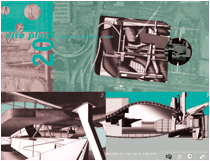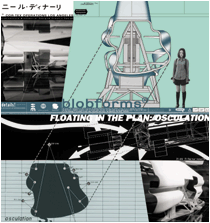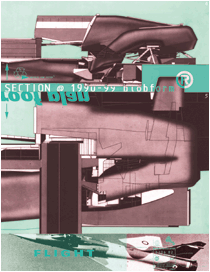
Bragança
de Miranda
Machine: The Funcional Impossibility
Carrilho da Graça
Performance (Interview)
Diller + Scofidio
Jump Cuts
Hani Rashid
The diference-Scape: The Digital Machine
Neil Denari
Interruped Projections
Rui Tavares
Seapking of Miguel Palma
Santa-Rita
The Mechanical Flirt
Machine: The Funcional Impossibility
Carrilho da Graça
Performance (Interview)
Diller + Scofidio
Jump Cuts
Hani Rashid
The diference-Scape: The Digital Machine
Neil Denari
Interruped Projections
Rui Tavares
Seapking of Miguel Palma
Santa-Rita
The Mechanical Flirt




"Interruped Projections:" Another Global Surface
1.0 The system or matrix of objects constitutes the material production of the world.
In theory, objects have a use-value or an instrumental nature. They are developed out of various existing or potential needs/desires of culture. Despite the utilitarian value of most objects, the possibility exists for any object to signify a status of itself or its user. Exchange-value of an object is determined in the market system of all related objects. Here, the object is a commodity. What follows from this is the symbolic or signform value of the object where performance, need, or utility fall away in the face of another, more superficial iconography of value such as the image or the logo.
1.1 Objects of Desire (in the libidinal economy) 1. Things: artifacts i.e. handy phones, portable computers, etc. /2. Humans: beauty, power, knowledge, money, authority, etc. / 3. Events: baseball, sexual intercourse, shopping, etc. /4. Images: anything
1.2 The Production of Consumption
If desire produces, its product is real... «Desire does not lack anything; it does not lack its object. It is, rather, the subject that is missing in desire, or desire that lacks a fixed subject...» P. 26 Anti-Oedipus, Gilles Deleuze and Felix Guattari.
Every act, every move, every strategy is a production intended for material, formal or social effects. Whether one buys, sells, or manufactures an object within the material matrix of production, a capitalist system is the economic framework by which public desire is monitored and indeed manipulated. Cause and effect, supply and demand, etc. are binary operations within capitalism and thus they are the reciprocating machines of progress and consumption. As these machines are self perpetuating, they withstand the traumas of the system, such as stock market crashes, burst bubble economies, failed mergers, depleted resources, etc. So, despite it all, we are always involved with the concept of objects of desire because our libido for consuming controls our passion for the commodity.
But what happens when the object no longer holds our focus or our anticipation of it overwhelms the objects´ very own reality? When the object ceases to fascinate, it exposes the fact that as Deleuze and Guattari point out, there is no subject inside desire. Despite the fixity of the object, desire cannot often times find an equally fixed subject, that is, what is this object about other than the fact that I have it and even though the object has a status signified by it, what is the good of that? What is the subject (matter) of this object?
One contemporary strategy for reinvesting the object with a subject (or a meaning) is to represent that object by the projection of its image or the coding of it by placing it under the commercial language of identification: the logo (or label or brand name). The use of well known figures in advertising, for instance, supplies a subject in advance of the object that person is pitching. So, if Michael Jordan endorses sneakers only for Nike, we perhaps now know more about the phenomenon of Air than we know about the product. Jordan is the conduit through which the subject may flow, directed at our desires to believe or to emulate. In fact, unwittingly, the subject becomes a commodity too. ...Or... If one buy the latest camcorder from Sony, it doesnŐt so much matter that it has a 45x zoom ratio or infrared steady shot optics as much as «it´s a SONY!» As it is a Sony, one has bought into the long-standing traditions of (Sony´s) technical progress at the forefront of world electronic production, of quality and miniaturization, and of signform value - that´s what the function of the logo is. These, ultimately, are not mere marketplace strategies designed to separate money from an individual. They are legitimate cultural practices that give desire a subject. They surround the object with a variety of conceptual surfaces that the individual may project his or her desire onto. Our satisfaction begins the moment we see what we want, even if it is not yet the real thing.
2.0 Mass production of consumer objects are deployed producing corporate wealth and identity.
The corporation, upon inspection, has perhaps the greatest degree of indifference to cultural or physiological needs in determining the possible production of an object. The logic of capitalism is primarily a kind of cultural logic. Product and company identity, usually manifest through advertising and graphic design, operate as a type of saturated code. that is where the logo appears over and over again in all corners of the world.
2.1 Logos not Topos
Corporate giants such as Sony, Microsoft, IBM, General Motors, Mitsubishi (etc.). Deploy slogans and images designed to become languages in themselves (Logo is a loan-word prefix from the Greek meaning "word" or "speech"). Repetition and similarity generates a set of defined characters that the individual may read with confidence or as one who understands the code. Thus, the more one feels a relation to the identity of a company, the more one may develop an identity about themselves as though the marketplace is the real site of describing one´s psychological make up, not the couch of the analyst or psychotherapist.
3.0 The signform overtakes/occludes the object as referent. The stretchy, logo-ized fabric is invented: worldsheet
The logo or identifying symbol merely becomes a sign, or further, a code in the move from an object based to a graphic based culture. Like DNA or computer codes, the graphic sign-codes may be mapped out and programmed to carry out certain tasks or performances. In the case of the graphic, the task may be that of seduction, or of infinite reproduction. It is possible, then, to imagine how the fluid plasmas of economics, communications, entertainment, etc. collapse onto a single homogeneous worldskin. The code for printing is the CMYK strip. It is the code that comes before the logo. The code for video projection is the trio of RGB lenses. They together conspire to make the images readable.
3.1 Code: encode > language 01.ASCII < binary «2. a system used for brevity or secrecy of communication, in which arbitrarily chosen words, letters, or symbols are assigned definite meanings. 3. a word, letter, or number, or other symbol used in a code system to represent or identify something.» from Random House College Dictionary
3.11 Gene.print > dbl helix/ DNA
DNA is a hereditary structure, therefore it is repeatable, potentially clonable, and an encoded index to behavior. 3.12 CMYK: cyan, magenta, yellow, black
Modern printing techniques have long used the four color separation process to accurately reproduce the smooth/continuous tones of analog image making (film photography). Each color is printed separately in a process that extrapolates the colored tones of the photo into separate but registered dots of the four colors. Millions of colors may be produced by the microscopic relations between dots.
3.13 RGB: red, green, blue
Video signals are encoded in a digital language such as PAL or NTSC which allows the tape head to read, though not optically, these signals on the tape. The signals are trisected into bands of information that are connected to each color in the projection system. As a kind of visual three color separation, the lenses are focused onto one another so that a clear image is produced.
3.2 Memory Surface: Structured Repetition: Worldsheet
Codes exist as structured language intentions of particular groups, organizations, companies, or processes that purposefully connect those involved in internal communication. With the advent of mass communications techniques [digital (audio and visual) and print], culture itself produces codes that in fact are codes on top of codes: or overcodes. This makes for a saturated visual culture where the individual must recognize sign-forms even before understanding the logic or meaning of the code itself. (Such as we must recognize an "A" to know that it means "A".) Somewhere, inside our heads, exists a space that contains the schematic textures of our contemporary world. We can almost literally make a series of blueprints out of this space onto which are inscribed the overloaded surfaces of image build-up, advertising residue, densified logos, and the general flak created by the visual and sonic explosions going off around us. Though each individual may arrange these elements differently on the surface, invariably the signforms of the language are objects and images known the world over. Our "secret" language, then, is merely a personal rearrangement of things that we all know. It becomes a language that communicates despite a private syntax. Imagine these blue prints woven together, making a fabric or net which pulls in, at an unbelievable rate, the cultural signforms of the external world.
4.0 This produces "another Global Surface" of practically homogeneous signforms.
(Ref. the IBM rain forest commercial where the guide goes on-line to get a map to locate the lost safari.) Through technology, the concept of the local site or real ground is changed. Digital technology is especially indifferent to location (electricity can be everywhere a battery can go!) The world in terms of technology is then more like a map than a real sphere. Perhaps it could even be called a graph where information such as GNP is more important than how many square miles of land a country or city has.
4.1 No more Landforms
Global economies and international exchange currencies have radically restructured our perception of the world. This, along with the constantly shifting borders of eastern Europe and some third world countries, has rendered land itself as perhaps merely a symbolic representation of power. The vast but non-resourceful territories of large continental countries like AustraliaŐs outback or Russia´s Siberian ice desert serve little purpose other than to "just be there". Meanwhile, in the imploded physical worlds of Tokyo, New York, or London, digital territories are created and annexed every second in the production of information while the codifications of these new zones allow us to access, for our pleasure, the inexorable flow of capitalist progress.
4.2 Overcoded Maps: Spheres of Influence Technology coerces a flattening of the world through its attempts to be horizontal and to be in all places at all times. It creates a new form of global projection or a new cartography depicting phenomena surrounding the flowing plasmas of money, knowledge, power, and politics. The new map is not a sphere tectonically, but a series of spheres of influence, regions of power which lay out the saturated and overcoded landscapes of desire. 5.0 Map comes from the Latin word for "sheet". Its origins are not in information, but in the geometry of the Flat Surface.
As a 2D plane, the sheet must be bent in order to architecturally spatialize a phenomenon. Its flatness is overcome by the powerful ability for architecture to momentarily intensify the graphic surface of seduction. 5.1 From the Graph (IC) to the actualized: 3d codes > architecture
My intention in parts 1 through 4 of this manual has been to outline the shifts in systems from the object to the code and to identify the saturating effects that new global languages have on our perception of the territorial and social landscapes of the world. In fact, the whole premise has been to flatten the concepts of real space (the earth as object or more specifically, architecture as object) into the horizontal codes of digital technologies and graphic sign-systems. The proposition is that architecture must be refashioned out of the fabrics of the logoized world, generating indeterminate envelopes of sheer resonance and cultural noise. Since the origin of map is sheet, the information on it may be purely graphic or expressive since map doesnŐt implicate anything more than a surface, a 2D plane. But, as a map is nothing without information on it, architecture too must intersect with the graphic to become a fully communicative spatial apparatus. In this, architecture is implicated as the most performative overcoded system of all, where function, signforms, shape, material, text, and even nature are layers of codes creating a dense but fluxual environment. In the contemporary world, it seems as if architecture should not function as a vessel or container of knowledge or the social. Such a fixed/closed idea of function retards the processes, filtrations, and overcodings that a supple architectural systems could provide. Instead, it should operate more like an extrapolation machine, a device capable of re-spatializing the dramatic currents and flows of culture, not merely a mirror held up to reflect it. By bending up (or down) the worldsheet, architecture is a sudden spatializing and transforming third dimensional phenomenon which actualizes and sets into motion the intertextualized codes. My scheme for the Gallery MA space is an overcoded diagram of this concept.
6.0 GOODE´S INTERRUPTED HOMOLOSINE PROJECTION depicts the world in 2D in a series of sheared ellipses.
This projection system is a combination of the Sinusoidal and Mollweide grids. These grids are interrupted and combined so that land masses can be projected with a minimum of shape distortion by positioning each section on a separate central meridian.
6.1 Flattened Topologies
Among the more than 50 different types of projection systems developed for representing the earth on a flat surface (sheet), the Interrupted Projection is most often used for its accuracy in depicting landforms while subordinating the oceanic areas to the distorted effects of the unfolded spherical surface. As water is only formed by the perimeters of the land adjacent to it, its "shape" is inherently non-existent, thus becoming a symbol of all phenomena which, too, are shapeless. Unlike the Mercator projection which flattens and distorts the world into a pure Cartesian atlas-like grid, the Homolosine is irregular in its form as it is cut out along various longitudinal meridians. Because of this, one can still detect "roundness" even within flatness, an implication of an architectural space of 2 dimensional curvatures. The Homolosine map is a virtual logo in its distinct profile and I have used it as a model for the deployable graphic surface within Gallery MA. The green worldsheet which re-animates and distorts the Cartesian space of the existing 3rd floor space at the Gallery MA is intended to be conceptually continuous and descriptive of the never-ending phenomena of the saturated graphic world around us. The topologies of self perpetuating geometries like the Klein Bottle,where there is no distinct inside or outside surface, have inspired the internally curving space, while the sheet of the map has constrained the green skin to that of a ribbon like 2D fabric, a prime printable (CMYK) surface.
7.0 Erase geographic information on the interrupted projection.
We are left with a silhouette du mondial (outline of the world). Fill in with logos and text for a realigned world. Projections of all kinds proliferate, crisscrossing and interrupting, flowing on and canceling out.
7.1 Vacuous > disarticulated and groundless Colonization, annexation, imperialism, expansionism, frontiers, (de)territorialization...think about these strategies in terms of digital and informational technologies. They can be applied to the world of the consumer, the stock market analyst, the CEO, or the PR strategist. Their maps have nothing to do with how many kilometers it is from Lagos to Bombay, or from St. Louis to Osaka. Indeed, the global condition threatens us with a homogenous landscape, where place is meaningless in the face of a radically persistent series of graphic sign systems designed to overcome distance and language barriers. Economic and cultural currencies have been, in recent times, forceful enough to destabilize our perception of the fixed boundaries of cities, nationalities, genders, and local customs. However, this erasing of clearly defined conditions, primarily due to the production of capitalist markets which are increasingly insensitive to place, has given rise to the codes which make our interpretations of the world more graphically and visually acute.
7.2 The new visual acumen we must have in order to decipher the complex sign forms of today means a more sophisticated if more volatile consumer of culture is also on the rise. Without the traditional map to guide us, locating oneself in the electronic ether is a new challenge. To navigate in the free floating econoscapes of signifiers and autonomous subjects, a literate and technically facile individual will no doubt continue to emerge and further, it is my argument that architecture will proliferate as an intersecting agent of spatialized fabrics.
7.3 White Noise: silent noise
The threat of homogeneity is also the threat of the generic. When everything is the same, then the cycles of reptition have created a drone which excludes the chance of difference occuring within the system: the monolithic culture ensues. But, does this lead to a radical boredom, or on the other hand, an overwhelming confusion? A delirium of possibilities? Can it be an organized matrix where libido and desire are charted against economies and politics within the backdrop of the graphic?
7.4 The Blank Green Surface of Merged Signs
The sea foam green worldsheet is largely blank in the Gallery MA scheme. Why? Because all is saturated and imploded. Even nature is extrapolated into a color which is both/neither natural or artificial...nature is invested with an arbitrary value which we must act upon in our search for identity |